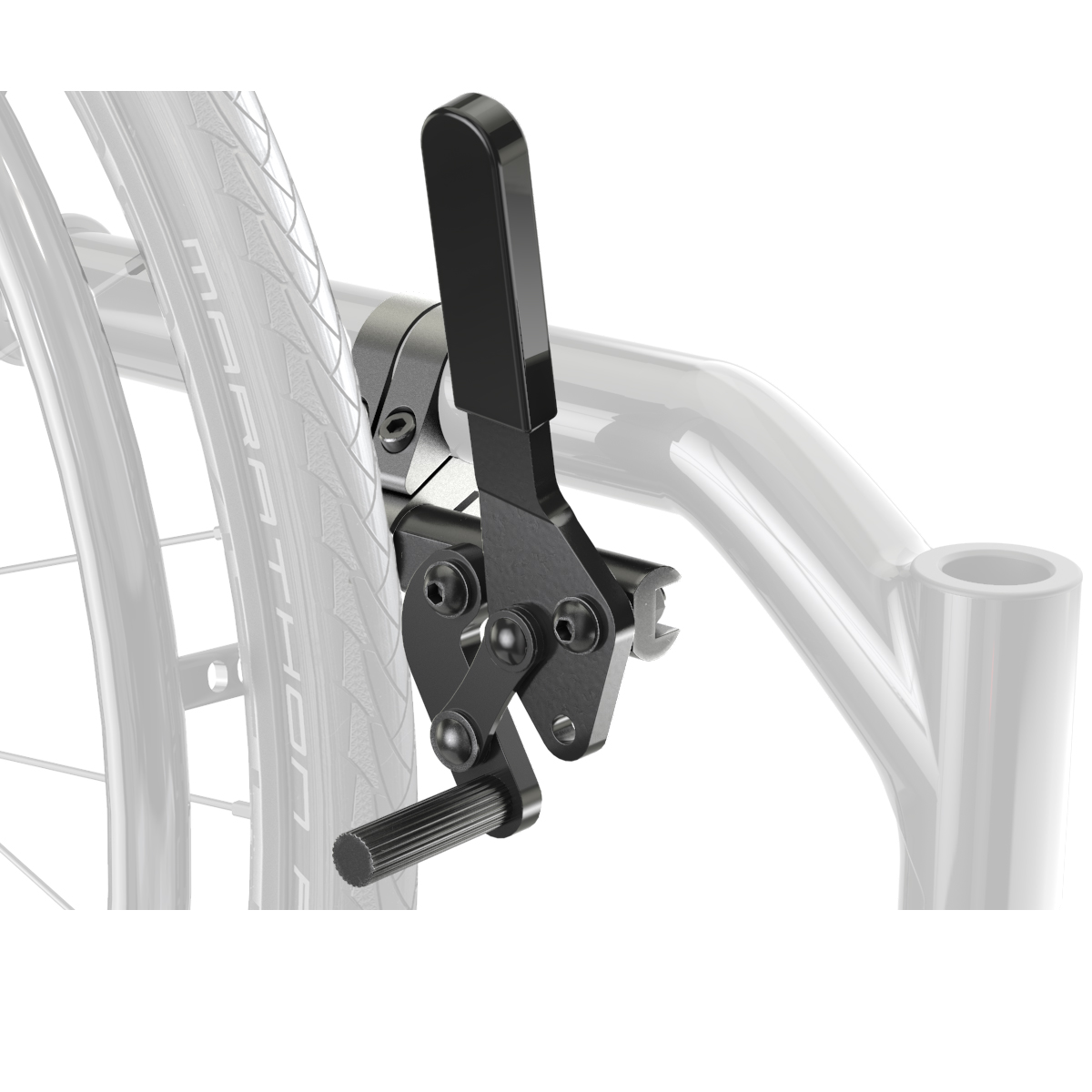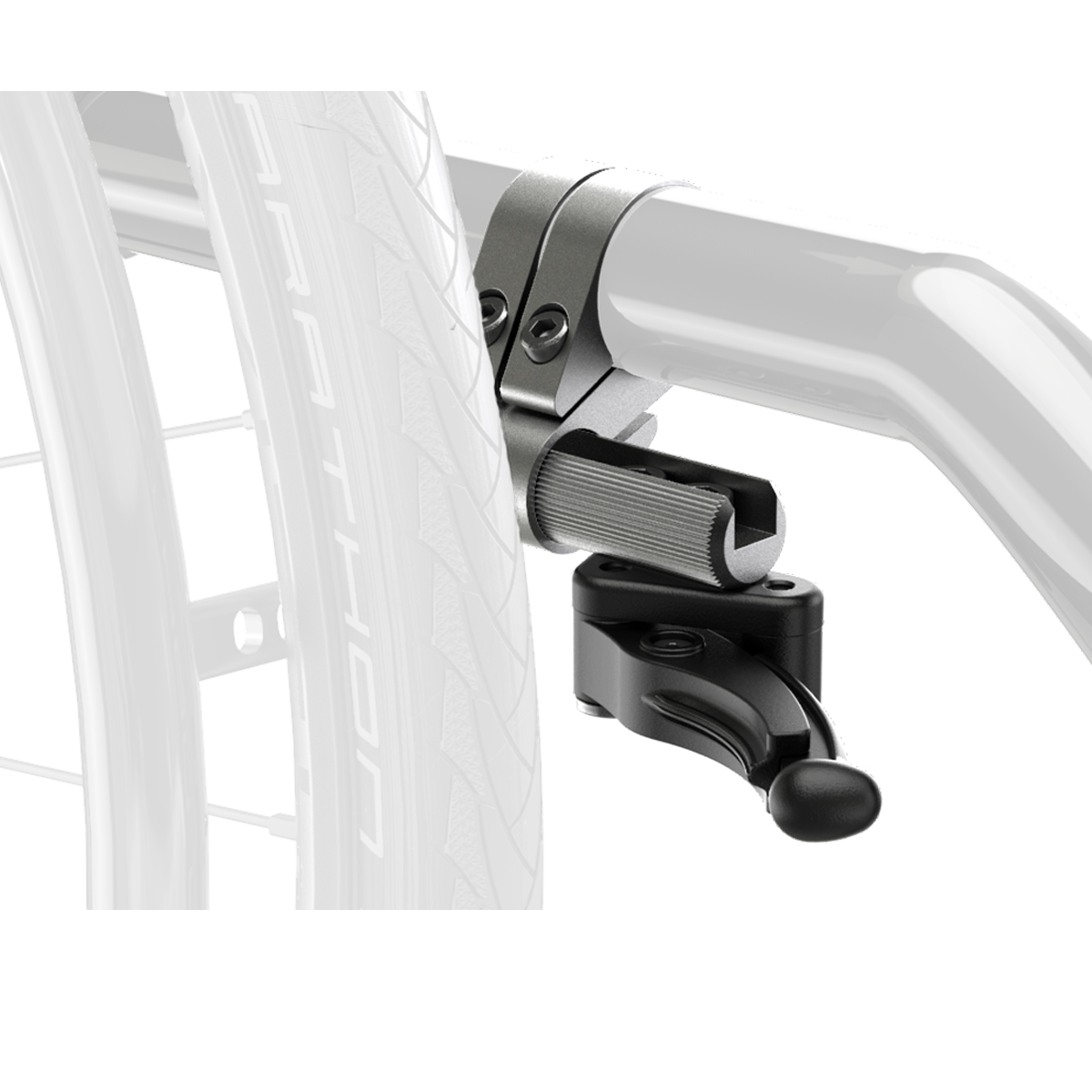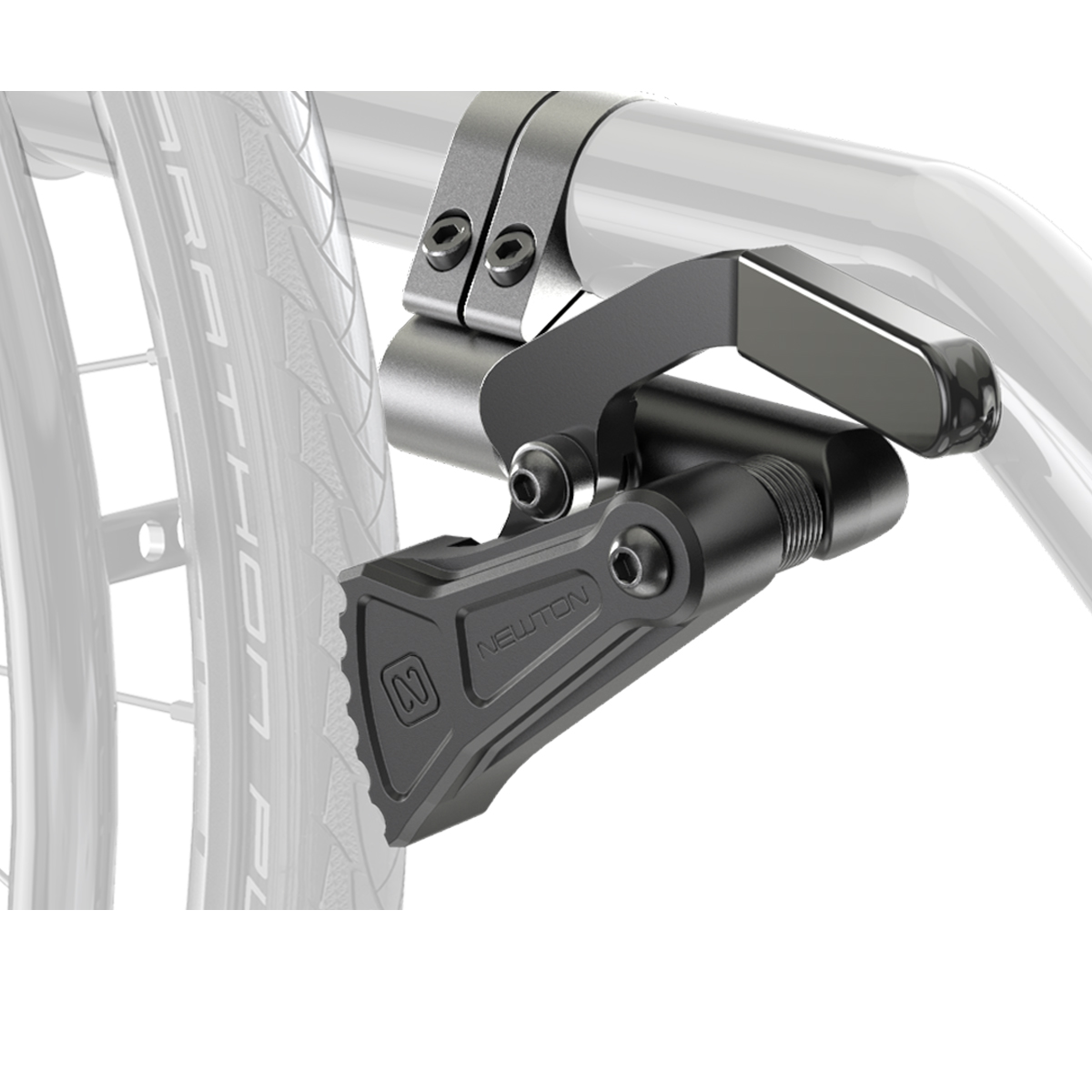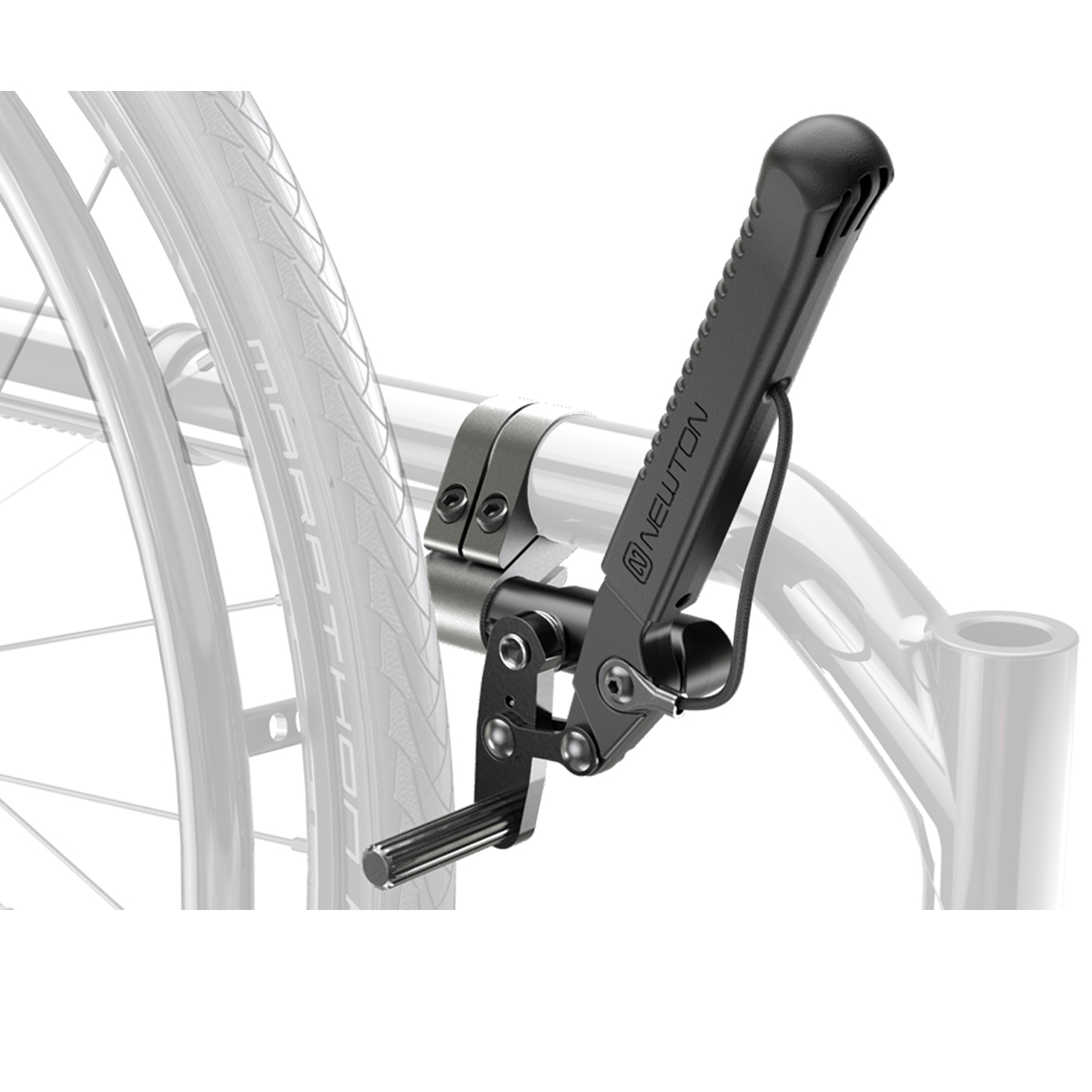Wheel locks: Unlocking Safety and Function
Proper selection and maintenance of wheel locks can ensure that wheelchair users are not only safe at rest but during propulsion as well.
Proper selection and maintenance of wheel locks can ensure that wheelchair users are not only safe at rest but during propulsion as well.
Often inaccurately referred to as “brakes”, wheel locks are not used to stop a moving wheelchair. Wheel locks keep a stationary wheelchair stationary, occupied or not. Whether stopped or in motion, wheel lock style and performance impact functional tasks and safety in varying environments.
Secure wheel locks facilitate safer transfers in and out of the wheelchair. However, any part of the lock that crosses the path of a transfer can create a skin integrity hazard to the user’s buttocks. Furthermore, wheel locks that cross the path of propulsion can injure fingers when the user is actively propelling. Adequately assessing how a type of wheel lock is attached and positioned when engaged and disengaged can reduce risk for injury.
Even a great wheel lock may require maintenance over time. If changes are made to wheel size, tire type, air pressure, wheel mounted power assist devices, or axle position, wheel lock function should be reassessed. Loose or rotated wheel locks will not function properly. This can allow a wheelchair to move during functional tasks, such as transfers, increasing risk for falls and injury.
The wheelchair user’s functional independence, upper body strength, and endurance with propulsion should be assessed to select the appropriate wheel lock. User’s must be able to both engage and disengage the wheel lock confidently and consistently. When in doubt, trial different styles of wheel locks to ensure the user is matched to the optimal lock. There are a variety of wheel lock styles available to meet the specific need and ability of every wheelchair user. Newton, Motion Composites’ high performance parts and accessories division, offers several ingeniously designed, ultralight weight, composite wheel lock solutions.
The most common types of wheel locks are the push to lock and pull to lock varieties. These wheel locks can vary from low end chairs to high performance chairs. When engaged, it is important that the handle does not impede the path of transfer in order to protect skin integrity. When disengaged, fingers can sustain injury during propulsion when caught in the assembly. Many push and pull to lock wheel locks are compatible with handle extensions for ease of operation. Push to lock is generally a safer option for transfers because the handle is pushed down and away when engaged. Some may find interference with push to lock wheel locks and swing away leg rests. Clients with stronger pulling ability may find the pull to lock wheel lock easiest to operate. Alternatively, wheelchair users with stronger pushing ability may find the push to lock wheel lock to be the easiest. Unfortunately, wheel locks are inherently flawed in their construction. Over time, the rotation of the wheel lock assembly will result in the gradual loosening of the screws on one side of the chair.


Newton wheel locks counteract this shortcoming by using reverse tread screws on one side of the chair. Furthermore, Newton wheel locks feature an ingenious spring mechanism that’s significantly more durable and functional than a standard wheel lock. Low profile, composite construction saves wheelchair users 1.3 ounces (38 grams) over conventional aluminum varieties.
Scissor locks offer a single lever mechanism for a low profile, unobstructive lock. The low profile scissor lock is positioned below the seat, keeping the device out of the path of transfer and the path of propulsion. This ensures the scissor lock is the safest wheel lock to prevent injury to the user. Newton’s low profile scissor locks are curved and grooved for improved contact and traction with the tire. These lightweight scissor locks are spring loaded for improved operation and function.

Grade Aids are a great option for wheelchair users who lack confidence, strength, or endurance with inclines. When engaged, the grade aid device prevents the wheelchair from rolling backwards while maintaining unobstructed forward movement. This device is simple enough for elderly and cognitively impaired users due to the tactile differences between free wheel and grade aid positions. Industry standard grade aids do not include a wheel lock mechanism and are of a heavy, bulky aluminum construction. Space on the side frame must be shared by both the grade aid device and the wheel lock.
Newton offers a combination grade aid wheel lock that provides three positions, free wheel, grade aid, and wheel lock. The ultralight composite construction weighs 30% less than its competitors and offers so much more. The low handle height enables smooth and unobstructed transfers to protect skin integrity. The combo grade aid wheel lock also automatically disengages before the thumb is injured during propulsion. The three tactile positions are even easier to learn and use than two separate devices. Space on the side frame is preserved, and the Newton grade aid is compatible with the 6” removable extension handle. This is the ideal wheel lock solution for pneumatic and high pressure tires.

Some wheelchair users have the upper extremity function to operate a certain wheel lock, but lack the balance or range of motion to reach the lock. These users may benefit from an additional accessory, the extension handle. Extension handles bring the access point closer to the user. These extensions are often removable for transfers but often remain tethered to the chair. Newton offers an extension handle, pictured below, that is compatible with the Newton push to lock, pull to lock, and grade aid wheel locks.

Wheelchair users who are unable to operate any wheelchair lock confidently, consistently, and independently due to physical or intellectual limitations may pass the task to a caregiver. The attendant wheel lock is a great solution for wheelchair users who do not operate a wheelchair independently. The ideal candidate would be with a caregiver anytime the attendant lock is disengaged. This client may live at home or in an institution. For this particular user, the attendant lock is the safest solution possible. The attendant lock is mounted to the rear of the wheelchair in order to be operated by a caregiver standing behind the chair. Some locks are operated by the attendant’s hand while others are operated by the attendant’s foot. The attendant lock can be used in addition to any of the aforementioned wheel locks if the wheelchair user is able to participate. Motion Composites offers an additional set of attendant locks that are mounted to the back.

Highly skilled wheelchair users who confidently and consistently transfer in and out of an unlocked wheelchair may opt out of using wheel locks altogether. These users achieve the lightest wheelchair configuration possible by minimizing parts and accessories on their high performance wheelchairs. These parts include anti tippers, locking backrests, push handles, wheel locks and so much more. Omitting wheel locks is not a suitable option for everyone and comes with significant safety risks.
There are other options for wheel locks in the mobility marketplace, including hub locks. Hub locks utilize a piston at the end of a cable to engage the locking mechanism at the wheel’s hub. Operated by the user, hub locks work regardless of changes in wheel size, tire tread, or tire pressure.
When choosing push to lock, pull to lock, scissor, grade aid, or attendant locks, remember lightweight, well designed locking solutions are available from Motion Composites. Participants in the wheelchair delivery process should consider user function, consistency, and safety when matching wheelchair users to the optimal wheel lock solution. Wheelchair users should trial different styles to ensure they can engage, disengage, transfer, and propel safely in the final selection. A variety of Newton wheel locks are available on form for all Motion Composites ultralight manual wheelchairs.
